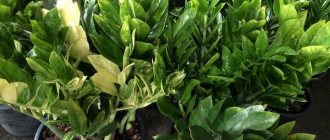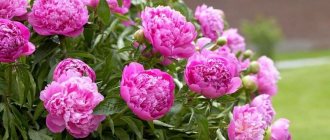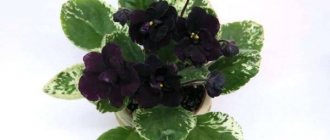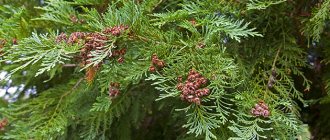The genus Zamioculcas is monotypic, consisting of a single species, Zamioculcas zamiifolia. It was first described in 1828, but became widespread in culture in 1996, when Holland presented the first batch of potted plants at auction. Popularity came immediately - the flower looks like an artificial one, valued for its high decorativeness and unpretentiousness. Zamioculcas Zenzi is a miniature variety, on the market since 2007.
Detailed description and photo
Zamioculcas Zenzi (Zamioculcas cv Zenzi) is a dwarf form of Zamioculcas , it grows up to 60-75 cm. The evergreen plant has a compact shape and pronounced colors.
At first glance, you might mistake this succulent for an artificial one. In addition, this flower has the amazing feature of hiding its miniature trunk in the ground. Instead of a stem, a small tuber is formed, where moisture reserves are accumulated. The tuber looks like a dark brown potato.
This is interesting. What is mistaken for a trunk is actually a leaf with individual leaf-like blades.
With good care it blooms, but very rarely . Most often, lovers are content with beautiful green leaves.
Some signs associated with the dollar tree
The name of the flower “dollar” appeared when it came to Russia, just a couple of decades ago. That’s what they called it in the West and transferred it to Russia, so it’s in dollars. And the meaning of this expression was formed from the signs that if you put it in the house, then a replenishment of funds is expected soon. This is because its leaves are bright green in color and very fleshy. Similarly, the crassula (money tree) was also brought from the same Africa.
In popular belief, zamioculcas is a flower of celibacy, but if you give it for a wedding and give a few coins in return, then it will only bring good luck to its owner. If it has taken root poorly and does not want to grow, and even more so has not bloomed for many years, then homeowners are pursuing false goals in life.
Bloom
Zamioculcas Zenzi blooms with inflorescences; they consist of a spadix and a spathe, which appear at the very base of the leaves. The spadix is an inflorescence consisting of small flowers of light shades: milky, light cream or yellowish, which smell quite pleasant.
The flowers are heterosexual and are found in inflorescences separately from each other. Women's - from below, men's - from above. Between them there are sterile flowers, they create a zone of sterility. Its role is to prevent plants from self-pollinating.
When and how does it bloom?
The flowering period occurs in spring . First, a small peduncle is thrown out, and a light leaf appears from it, covering the inflorescence. The Zenzi flower itself is inconspicuous.
The blanket has the same color as the rest of the leaf blades. For this reason, the inflorescence is difficult to see. The cob is first directed upwards, a little later, as it ripens, the cob begins to lean toward the ground.
What do the fruits look like?
The inflorescence itself is inconspicuous; it is formed on a small fleshy stem.
Zenzi blooms rarely, and fruits appear even more rarely in the form of small brown berries, and the seeds practically never ripen completely .
How much does an adult plant cost, where can I buy it?
Mature, mature plants can be purchased subject to availability and on order in flower shops. Good deals can be found in online stores.
In the Miltonia store, serving Moscow and the Moscow region, depending on the height of the leaves, prices are distributed as follows :
- 1550 rubles for a plant 50 cm high.
- A 60-centimeter flower costs 2880 rubles.
- It is possible to order delivery of plants with a height of 75 cm.
Hobbyists distribute Zenzi through social networks and sell it on online platforms.
Landing
Most often, the plant is grown from seeds or tubers with a pair of shoots.
Choosing a pot
Choose a tall pot, 3-5 cm larger than the tuber. In such a pot there will be room for both the stem and the roots.
- Young plants are planted in clay pots, they are replanted every year, and there is no danger of damaging the stem.
- Adult plants are transplanted as the underground part grows, which, as it develops, can fill the entire pot and even deform its walls. It is convenient to plant adult Zenzi in flexible pots, which can be cut painlessly for the plant and remove the tuber without damaging it. For beauty, such pots can be placed in flowerpots.
What should the soil be like?
Since Zamioculcus is a succulent, a suitable planting substrate for cacti . If you collect the soil mixture yourself, then the proportions are as follows: equal parts of leaf soil, peat, sand and turf soil. You need to add small pebbles and coal to the mixture.
How to plant?
- Place drainage made of expanded clay or small pebbles at the bottom of the new pot so that it occupies a quarter of the container.
- Add soil mixture.
- Place the tubers in the center of the pot.
- Add mixture.
- Do not water.
- Make the first watering after 5-7 days.
Reproduction
Theoretically, Zamioculcas Zenzi can be propagated by seed, but this requires it to bloom. It is often impossible to achieve this, so it is better to use other methods that are more effective.
Zamioculcas propagation by leaf, tuber or compound leaf is carried out in the spring, since during this period the plant is full of energy, receives fertilizing and takes root faster.
A FEATHER AND A COMPLEX LEAF (SHUTTING)
How to propagate a dollar tree with a feather or a compound leaf:
- Choose a healthy shoot or leaf.
- Cut it at a 45 degree angle with a sharp knife.
- Air dry for two days.
- Treat with root to stimulate root formation.
- Immerse in wet sand-peat substrate. The compound leaf is placed in water for root formation.
The container with the sheets is covered with a bag or glass to maintain the microclimate. Once a day you need to ventilate the seedlings and remove condensation.
The process of tuber growth with this method is long - up to 6 months, so you need to be patient. When new leaves appear, you can transplant them into a separate pot.
The cutting is a whole leaf. To propagate a plant, proceed as follows:
- Cut off the sheet and remove the bottom 4-5 segments.
- Dry the cuttings in the shade.
- Sprinkle the cut with charcoal powder.
- We plant it in a pot with soil and place it in an indoor greenhouse. Option: place the lower end in a jar of water or wet hydrogel. Keep the water clean.
- After the roots and nodules appear, we plant them in a pot and cover them with a plastic bottle.
- When new leaves sprout, the cover can be removed.
TUBER DIVISION
How Zamioculcas reproduces by dividing the tuber:
- Remove the root from the pot.
- Divide the tuber so that each part has a growing point.
- Treat the sections with activated carbon and leave to dry for a day.
- Plant all the parts in new pots so that some are above the surface of the soil.
for 2 months , but are watered little by little to keep the soil moist. Important! Only adult healthy zamioculcas can be propagated by tubers.
Features of plant care at home
Zenzi is easy to care for . However, for better formation of leaves, you need to turn the pot from time to time so that they are all illuminated evenly. The plant loves cleanliness, so you need to give it a shower and also wipe the leaves from dust. There is no need to spray the plant; it loves dry air.
Temperature
The plant feels great in summer at a temperature of +21-32°C, in winter +16-18°C, but not lower than +15°C - this is the critical point at which the green pet can die.
Lighting
Loves the sun, but does not tolerate direct sunlight on the leaves . It tolerates shading well, but under these conditions plant growth slows down. Should be placed on southern and south-eastern windows, providing protection from bright sun. In summer, take it out onto the loggia or into the garden.
Watering
Should be moderate. Stagnation of water and excess moisture are unacceptable. You need to water the flower generously, then pour the water out of the tray or flowerpot. The roots should not come into contact with water for a long time. The plant is watered 1-2 times a week, making sure that the top layer of soil is dry to a depth of 3 cm. In winter, less often.
Attention . You don’t have to water it for 2-3 weeks; the plant will extract accumulated reserves from the tubers. But in this case, there is a danger that the plant will begin to prepare for a period of drought.
Top dressing
During active growth, from mid-spring to September, liquid fertilizing should be applied . You need to choose among fertilizer options for cacti and succulents.
Trimming
Old branches and branches with yellow leaves that have lost their beauty should be removed regularly. Since the plant is dwarf, there is no need to pinch the growth point; the leaves will reach 60-75 cm and stop growing. But you can carry out formative pruning - remove improperly growing shoots.
Transfer
Young plants are replanted every year, then once every 3-5 years, as needed. All work should be carried out according to general rules.
Care during the flowering period
If the plant has bloomed, continue watering and fertilizing. Do not move from place to place . After flowering, remove the peduncle.
What to do if it doesn't bloom?
Provide the plant with all the necessary agrotechnical techniques, keep it in the light and wait.
Zamioculcas transplant
The variety grows slowly and can live up to 5 years in one pot. Sometimes owners engage in transshipment only when the container not only becomes deformed, but bursts. This helps to restrain growth - after all, Zamioculcas Zenzi is valued precisely for its dwarfism.
The pot should:
- have several fairly wide lower holes for the unimpeded drainage of excess moisture;
- be 2-3 cm larger than before if the transplant is carried out without stripping the tubers or dividing the bush.
The substrate for Zamioculcas Zenzi is suitable for store-bought cacti. It is useful to add about 20% mineral leavening agents:
- vermiculite;
- red brick chips;
- expanded clay;
- coarse sand;
- baked clay;
- pumice;
- zeolite;
- lava.
Transplant process:
- Take Zamioculcas Zenzi out of an old pot.
- Inspect the roots.
- If necessary, clean rotten or dry areas down to living tissue. Sprinkle with crushed activated carbon and allow to dry until callus forms.
- Place drainage and some soil mixture on the bottom of the container.
- Place the Zenzi in the middle so that after transplantation the rhizome is covered with a thin layer of earth. Leaving the top of the underground stem exposed is wrong.
- Add and crush the substrate.
- Watering is done every other week.
Diseases and pests affecting this dwarf species
The most common diseases are:
- Root rotting occurs from low temperatures or frequent watering, as well as from stagnant moisture. Treatment: remove rotten roots, wash the rest in fungicide or potassium permanganate. Dry before planting.
- The yellowing of leaves is a natural process. But if later the leaves do not grow back, then the reason lies in the lack of watering or fertilizing; it is possible that the plant is standing in a draft. Treatment: remove the cause.
Pests:
- Aphids - treated with Fitoverm or Aktara.
- Spider mites - the plant should be treated with insecticides.
- Scale insects - remove with a damp swab or soap solution. It is best to use insecticides.
Zamioculcas Zenzi is an unpretentious plant with beautiful bright green leaves that will decorate any interior. It will delight its owner all year round.
Trimming
Pruning is not a prerequisite for proper plant care. It is carried out only to give it a certain shape or rejuvenation. You can trim any part of the plant: tuber, leaves, cuttings. The main thing is that the pruning tool is very sharp and sterile. A scalpel, garden pruning shears, and a sharp knife will do.
Also read: Hypocyrta: an ornamental plant with bright flowers - “fish”
The cut area must be sprinkled with crushed activated carbon. This will quickly stop the leakage and block access to the “wound” for pathogenic microorganisms. Often pruning is used to treat the currency tree.











